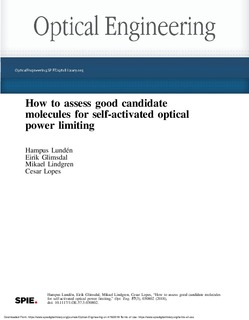| dc.contributor.author | Lunden, Hampus | |
| dc.contributor.author | Glimsdal, Eirik | |
| dc.contributor.author | Lindgren, Mikael | |
| dc.contributor.author | Lopes, Cesar | |
| dc.date.accessioned | 2018-04-20T06:36:57Z | |
| dc.date.available | 2018-04-20T06:36:57Z | |
| dc.date.created | 2018-04-04T10:54:14Z | |
| dc.date.issued | 2018 | |
| dc.identifier.citation | Optical Engineering: The Journal of SPIE. 2018, 57 (3), . | nb_NO |
| dc.identifier.issn | 0091-3286 | |
| dc.identifier.uri | http://hdl.handle.net/11250/2495177 | |
| dc.description.abstract | Reverse saturable absorbers have shown great potential to attenuate laser radiation. Good candidate molecules and various particles have successfully been incorporated into different glass matrices, enabling the creation of self-activated filters against damaging laser radiation. Although the performance of such filters has been impressive, work is still ongoing to improve the performance in a wider range of wavelengths and pulse widths. The purpose of this tutorial is, from an optical engineering perspective, to give an understanding of the strengths and weaknesses of this class of smart materials, how relevant photophysical parameters are measured and influence system performance and comment on the pitfalls in experimental evaluation of materials. A numerical population model in combination with simple physical formulas is used to demonstrate system behavior from a performance standpoint. Geometrical reasoning shows the advantage of reverse saturable absorption over nonlinear scattering due to a fraction of scattered light being recollected by imaging system optics. The numerical population model illustrates the importance of the optical power limiting performance during the leading edge of a nanosecond pulse, which is most strongly influenced by changes in the two-photon absorption cross section and the triplet linear absorption cross section for a modeled Pt-acetylide. This tutorial not only targets optical engineers evaluating reverse saturable absorbing materials but also aims to assist researchers with a chemistry background working on optical power limiting materials. We also present photophysical data for a series of coumarins that can be useful for the determination of quantum yields and two-photon cross sections and show examples of characterization of molecules with excited triplet states. | nb_NO |
| dc.language.iso | eng | nb_NO |
| dc.publisher | Society of Photo-optical Instrumentation Engineers (SPIE) | nb_NO |
| dc.title | How to assess good candidate molecules for self-activated optical power limiting | nb_NO |
| dc.type | Journal article | nb_NO |
| dc.type | Peer reviewed | nb_NO |
| dc.description.version | publishedVersion | nb_NO |
| dc.source.pagenumber | 13 | nb_NO |
| dc.source.volume | 57 | nb_NO |
| dc.source.journal | Optical Engineering: The Journal of SPIE | nb_NO |
| dc.source.issue | 3 | nb_NO |
| dc.identifier.doi | 10.1117/1.OE.57.3.030802 | |
| dc.identifier.cristin | 1577203 | |
| dc.description.localcode | © 2018 Society of Photo Optical Instrumentation Engineers. One print or electronic copy may be made for personal use only. Systematic reproduction and distribution, duplication of any material in this paper for a fee or for commercial purposes, or modification of the content of the paper are prohibited. | nb_NO |
| cristin.unitcode | 194,66,20,0 | |
| cristin.unitname | Institutt for fysikk | |
| cristin.ispublished | true | |
| cristin.fulltext | original | |
| cristin.qualitycode | 1 | |
